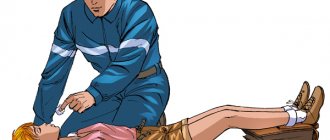The earliest manifestations of confusion and disorientation include a sharp decrease in concentration. During progression, there is a complete disruption of sensitivity to the outside world, memory lapses occur, logical thinking is modified, the patient does not understand what is happening, recognizable memory and full-fledged speech are impaired, and emotional distress occurs. As a result, depression, silence and inactivity of a person are recorded. The psychiatrist must distinguish between these aspects and provide a presumptive diagnosis when communicating with the patient.
What is a confused state?
In this process, the ability to think at an average speed disappears, the clarity and consistency of thoughts is significantly destroyed.
Content:
- What is a confused state?
- Causes
- Symptoms
- What is disorientation?
- Current of development
- Medical classification
- Symptoms of the disease
- Benefits of diagnostics
Signs of the disorder are problems with orientation in space and deterioration of attention. Logical thinking disappears and memory is degraded. The highest signs of the psyche change one by one. For example, only speech recognition may be affected. Memory problems are noted, spatial orientation is impaired. There are two types of confused consciousness, depending on the cause of its occurrence - fast and slow.
Manifestations can be one-time or permanent. Dementia and delirium are signs of the latter condition. The integrative function of thinking at the moment of confusion is absent. Along with the expected change, the patient is often silent, moves little, and is depressed outwardly. Illusions and hallucinations accompany the disease. The first arise because the body incorrectly perceives the stimulus, while hallucinations manifest themselves independently. Each person suffers from the disease differently - the determining factor is the underlying cause of the development of the disorder. Slowness of thinking and inconsistency of logical series are emphasized during the first minutes of conversation. Even non-professionals can notice the initial symptoms.
Psychotherapists divide delirium into several classifications: hallucinatory (the ability to see non-existent information); manic (obsession with aggression); catatonic (inability to fully move); confabulatory (twisting of an obvious fact).
What will happen next?
The next step for effective treatment of multiple sclerosis, as the expert notes, is the search for a marker that will suppress not all B-lymphocytes, but only those that harm the body. In the treatment of some autoimmune diseases, such markers can be found, that is, it is possible to understand what distinguishes autoreactive B lymphocytes from ordinary ones.
However, today there is no talk of a complete cure: despite the latest discoveries, any therapy for multiple sclerosis is for life. Unless scientists understand the cause of its occurrence and ways to eliminate it, which, as practice shows, is quite possible.
Causes
The following reasons for the occurrence of the phenomenon of confused consciousness are identified:
- traumatic (consequences of penetrating traumatic brain injury);
- in case of brain injury (organ tissues are highly sensitive);
- the occurrence of an aneurysm (an enlarged blood vessel affects neighboring tissues);
- mercury poisoning;
- increased dose of alcohol in the blood;
- drug intoxication;
- effects of neurotropic gas on the respiratory system;
- entry of organophosphorus compounds into the digestive system;
- poisoning with neurotoxic substances – puffer fish, mushrooms, carambola;
- hyperthermia resulting from infectious diseases;
- pain shock during a fracture, dislocation, significant blood loss;
- severe diseases - tuberculosis, encephalitis, diabetes mellitus, all types of hepatitis, acquired human immunodeficiency syndrome at the final stage of development;
- progression of the growth of a cancerous tumor at the last stage - decay (during the process intoxication occurs);
- coronary heart disease, all types of strokes, occurring both unnoticed and obvious;
- myocardial infarction, with pronounced pain and impaired blood flow;
- vegetative-vascular dystonia – dilation of blood vessels occurs in areas of the autonomic nervous system of the body;
- age-related diseases: senile dementia, Alzheimer's disease, marasmus of all types;
- bright emotional outburst;
- hypothermia;
- a period without sleep for a long time;
- oxygen starvation;
- 1st and 2nd degree stunning.
Non-productive disorders of consciousness
Nonproductive disorders of consciousness include stupor, stupor, and coma.
Causes of impaired consciousness
Disorders of consciousness can occur due to the following reasons:
- brain injury;
- neoplasms;
- vascular pathology;
- dysmetabolic disorders in diabetes mellitus, uremia, myxedema, hepatic and renal coma;
- intoxication with alcohol, organophosphorus or narcotic substances and medications.
Impaired consciousness may be associated with a sharp drop in blood pressure during acute blood loss, during a sudden rise from bed while remaining in a horizontal position for a long time, especially in a stuffy room. In case of pain, fear, emotional shock, coughing, defecation or urination, disturbances of consciousness may also occur. They are also caused by acute vascular disorders that develop as a result of myocardial infarction, pulmonary embolism and cardiac arrhythmias.
Types of disorders of consciousness of non-productive type
Unproductive disturbances of consciousness can be in the form of stupor (stupor), stupor and coma.
Stupor is a condition in which drowsiness, fatigue, and lethargy are expressed. A person loses the ability to answer complex questions, his memory is reduced, his answers are monosyllabic, sometimes incorrect, he often gives them after a long pause. However, he retains the ability to navigate place and time, as well as his own personality.
Stupor is a disorder of consciousness, which is characterized by deep depression of mental activity and complete disorientation. The patient can react to external stimuli with facial expressions, movements or voice, however, the responses are not always purposeful, they are depleted quite quickly. It is almost impossible to achieve adequate communication with the patient.
Coma is an extreme degree of disorder of consciousness: there is no consciousness, the work of all analyzers is disrupted and the vital functions of the body are disrupted. When the brain is damaged, cerebral coma occurs, and in the case of secondary effects on the brain substance of various damaging factors, such as temperature, intoxication or metabolic products, they speak of extracerebral coma.
Cerebral coma is manifested by an unconscious state, a violation of motor, somatic and sensory functions. As the coma progresses, both the depression of consciousness and the weakening of reflexes increase until they disappear completely. In the absence of focal brain damage, pathological signs similar to the Babinski reflex appear first on both sides and then disappear. Characteristics of meningeal lesions are Kernig's and Brudzinski's symptoms and neck stiffness. Hemodynamics and breathing are impaired, and then death occurs. Emergency care for non-productive disorders of consciousness
In order to help a patient who is in a state of stunning, stable contact should be established with him. This can be achieved with a light slap in the face and sprinkling with cold water. You can give the ammonia solution a sniff. The patient should be placed on a horizontal surface and legs elevated at an angle of 75°. You can sit him down, tilt his head forward, grab the back of his head with his palms and ask him to raise his head. Rubbing your earlobes can also be effective.
Stupor, like coma, requires medical treatment. The patient must be hospitalized in the intensive care unit, and in case of skull injury or hemorrhage in its cavity, in neurosurgery. The patency of the upper respiratory tract is restored and tracheal intubation is performed. For hypotension, infusion solutions that have an antishock effect, pressor amines, norepinephrine and dopamine are administered. In case of arterial hypertension, antihypertensive therapy is carried out.
Symptoms
For a primary diagnosis, it is necessary to detect the active progress of processes:
- shallow memory lapses (information is lost within a few minutes);
- the patient cannot recognize his loved ones, as well as basic passport data;
- there is no memory of the person’s information field;
- disorientation;
- unconditional changes in mood (an aggressive mood can manifest itself even among close people);
- there is no logical chain in the pronunciation of phrases (pronunciation speed is below average);
- lack of control over the bladder and sphincter (constant urination and defecation);
- Normal sleep is completely disrupted.
Sometimes the cause of such manifestations is cervical osteochondrosis. The clinical picture in this case changes - pain in the cardiac and chest region is added, movement is limited, and there is increased sweating.
Due to internal bleeding, additional aspects appear: excessive sweating; pale skin; black stool; high blood pressure; worsening breathing; tachycardia.
Psychological disorder, in turn, entails inappropriate behavior, aggressive attacks, lack of normal sleep, terrorizing the immediate environment, the emergence of helplessness and the collapse of a clearly established internal model of behavior.
If the patient experiences the changes described above, you should immediately contact your local psychiatrist. Next, a conversation is held, but not in private, but in the presence of a relative. Additionally, blood donation is prescribed for general and biochemical blood and urine tests. An electrocardiogram, ultrasound examination of internal organs, Doppler sonography of all key vessels, magnetic resonance imaging if necessary, and oral consultation with specialists are performed.
What's new?
Today there are several innovative developments that may in the near future change the approach to the treatment of multiple sclerosis. “We are talking about the so-called targeting of the B-cell component of immunity. Our body has quite powerful resources for self-healing, in particular, axonal membranes destroyed by T-lymphocytes restore special cells: oligodendrocytes. However, in multiple sclerosis, they are destroyed by other immune cells: B-lymphocytes. That is, it turns out that T-lymphocytes trigger the immune system’s reaction against myelin, and B-lymphocytes prevent the body from repairing itself.
The idea behind the new therapy is quite simple: you need to suppress the activity of B lymphocytes so that they do not interfere with oligodendrocytes restoring the myelin sheath of axons. Scientists consider this a major breakthrough: studies demonstrate the effectiveness of the method for any type of multiple sclerosis. Today there are several drugs based on targeted B-cell therapy, including our Russian one. The third phase of its clinical trials will begin in the near future. According to forecasts, it may appear on the market as early as 2023,” says Pavel Yakovlev.
Article on the topic
Sclerosis, but not that one. What are the signs by which diffuse pathology is recognized?
What is disorientation?
It is classified as a mental disorder and can cause certain changes in the functioning of the central nervous system. It is divided into short-term and long-term, depending on a number of factors. The patient is unable to describe himself as a person; there is no temporal and spatial orientation. It should not be confused with childhood social disorientation, which is a temporary age-related process. The phenomenon is divided into two types: allopsychic, autopsychic. In the first case, there is an inability to determine location, as well as to separate time periods. In the second case, it is impossible to name the first name, last name, patronymic, date of birth, place of residence. For diagnosis, the right questions are asked and clarity is established. If it is confused, urgent consultation with a psychiatrist is necessary. To be admitted to a psychiatric hospital, the patient's voluntary consent to medical care is required. Impaired consciousness makes it impossible to objectively assess the situation; hospitalization is carried out according to the estimated condition at the time of treatment. Direct relatives and family members can help expedite legal issues.
Why does multiple sclerosis occur?
Today, doctors and scientists have studied quite well how the disease begins and progresses, what the possible scenarios for its development and complications may be. But the root cause of its occurrence is still not fully understood, which in general can be said about all autoimmune diseases, which include multiple sclerosis, notes Pavel Yakovlev. “Globally speaking, any autoimmune disease is a violation of the ‘friend or foe’ code. The function of the immune system is to recognize a potential threat to the body’s functioning and destroy it. Sometimes this system malfunctions and immune cells - T-lymphocytes and B-lymphocytes - begin to perceive some body cells as foreign and attack them,” says Yakovlev.
There are a number of factors that, according to scientists, have a significant impact on the incidence of multiple sclerosis. Firstly, the disease is more common in northern latitudes: according to statistics, Norway ranks first in the number of patients with MS. Doctors attribute this to a lack of vitamin D, specifically the one produced in the body. Secondly, women are much more likely to suffer from multiple sclerosis. There is an opinion that there is a genetic predisposition to the disease (as, for example, with ankylosing spondylitis, another autoimmune disease), but for now this remains at the level of hypothesis.
Current of development
To correctly establish the primary diagnosis, it is necessary to note the causes of the anomaly. Fundamental experts identify the following factors:
- psychological disorders leading to a serious disorder in consciousness;
- stress, nervous overstrain;
- exceeding the norm of ppm alcohol in the blood;
- drug intoxication;
- medications: tranquilizers, antidepressants, sedatives;
- long-term exposure to increased background radiation;
- period of recovery from anesthesia;
- progressive depression;
- Alzheimer's disease;
- senile pseudosclerosis;
- vegetative-vascular dystonia;
- schizophrenia;
- hypoglycemia;
- senile dementia;
- lack of water resources in the body;
- insufficient kidney function;
- epileptic disease;
- malignant brain tumor;
- benign brain tumor;
- hyperthermia;
- infection with encephalitis tick.
Disorientation can be observed during a high-power impact and in a large emotional outburst. With this development, fainting often occurs. A one-time case is not a consequence of the occurrence of pathological processes. However, to be on the safe side, a consultation with a psychiatrist is necessary.
Is this senile sclerosis?
“Let's start with the fact that multiple sclerosis has nothing in common with the so-called “senile sclerosis”. The confusion stems from the translation from English “multiple sclerosis,” where “sclerosis” is understood as a scar: the replacement of organ tissue with dense connective tissue. This process can begin in almost any organ, for example in the vessels of the brain, disrupting normal functioning and causing various symptoms such as memory impairment,” says Pavel Yakovlev.
At the same time, as the expert notes, multiple sclerosis is the formation of scars at the ends of nerve processes: axons. All of them are in a shell made of a special protective substance: myelin. It is this that, as a result of a malfunction in the immune system, lymphocytes begin to destroy.
A life-changing illness. Myths about multiple sclerosis Read more
Medical classification
Best materials of the month
- Coronaviruses: SARS-CoV-2 (COVID-19)
- Antibiotics for the prevention and treatment of COVID-19: how effective are they?
- The most common "office" diseases
- Does vodka kill coronavirus?
- How to stay alive on our roads?
Disorientation is classified into radiation, occupational, spatial and social symptoms. Psychiatry identifies the term “autopsychic disorientation” - the lack of perception of personal factors (the inability to reproduce the last name, first name, patronymic, date of birth, that is, identification data). With this phenomenon, the individual’s surrounding world changes, and orientation in it is completely absent. A double perception of the world is noted, a real and imaginary environment is created, alternately visited by the psychological inner world. The full picture emerges after a proper examination by a doctor.
Naive T lymphocytes
T lymphocytes are produced in a special part of the brain: the thymus gland. There they undergo so-called “training”, that is, they are differentiated: they learn to recognize and destroy the threat. “One of the stages of differentiation is negative selection. In this case, the trained lymphocytes are shown fragments of body cells to which they should not react. And if they react, that is, potentially self-reactive, then they are destroyed. It is at this link in the chain that failure can occur. During training, the T-lymphocyte may “not see” the cell to which it will subsequently react, after it enters the central bloodstream,” explains Pavel Yakovlev.
Article on the topic
Multiple sclerosis is not forgetfulness. How to recognize a dangerous disease?
Symptoms of the disease
Changes that help establish the diagnosis are pronounced dizziness, variable mood, disturbed sleep, problems with remembering facts, inability to identify a person, internal psychological anxiety without outside provocation.
Spatial symptoms stand out: a sharp change in mood - an apathetic state changes to an aggressive one.
Help in this situation can only be found in a specialized institution that works with psychologically unbalanced people.
A separate category is social disorientation, which cannot be classified as a mental disorder. Its specific features: unclearly pronounced age, long-term adaptation to society, anxiety in an unusual situation.
Vegetative-vascular dystonia provokes worsening symptoms - vomiting, active progressive dizziness, tinnitus, complete or partial hearing loss, headaches, and fluctuating blood pressure.
The diagnostic complex involves an initial consultation with a psychiatrist and a neurologist. The doctor performs manipulations with the patient, a full physical examination with questions to help establish the correct diagnosis. From the point of view of physical manipulations, there is blood sampling for biochemistry and general clinical analysis. A test is performed to detect drugs in the body. Mandatory coagulogram and magnetic resonance imaging of the brain. At the same time, the patient is sent for specialized tests to identify his psychological level.
General information
Confusion is a pathology in which a person’s ability to navigate in time or space is impaired. At the same time, attention may decrease, and sometimes there are lapses in short-term memory. Such manifestations are associated with impaired brain activity and can be a symptom of both mental and somatic diseases. Various conditions can provoke them: acute intoxication , dehydration, heat stroke , hypothermia, severe stress, etc.
In this state, a person can wander the streets, get confused in time, look lost and distracted. Pathological disorientation often develops in older people suffering from neurodegenerative diseases and brain lesions. If the process progresses, the patient may experience impaired perception and memory, recognition and speech. Emotional disorders, etc. are noted. Neuropsychological and clinical methods are used in the diagnostic process. Treatment is conservative.
The treatment methods and features of this condition will be discussed in more detail in this article.
Consequences and complications
Disorientation and confusion are symptoms that can greatly limit people's social and physical activities. If adequate treatment is not provided, the condition may gradually worsen. Confusion may increase, making it difficult for a person to make decisions independently and carry out usual actions.
Frequent complications are anxiety and depressive disorders , behavioral abnormalities, manifestations of aggression , etc.
Diet
Diet for the nervous system
- Efficacy: therapeutic effect after 2 months
- Timing: constantly
- Cost of food: 1700-1800 rubles per week
People prone to confusion should follow a healthy diet and avoid vitamin and mineral deficiencies. Nutrition should be complete. It is important to adhere to the recommendations given by the doctor, taking into account the characteristics of the disease.
It is recommended to include the following products in your diet:
- Vegetables, fruits, greens.
- Seafood, seaweed.
- Lean meat.
- Cereals.
- Nuts, seeds.
- Honey.
It is recommended to completely abstain from drinking alcohol, and also to minimize smoked foods, pickles, preserves and other harmful foods.










